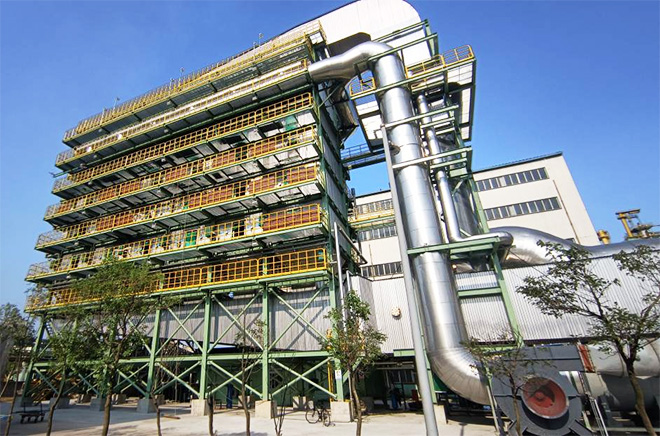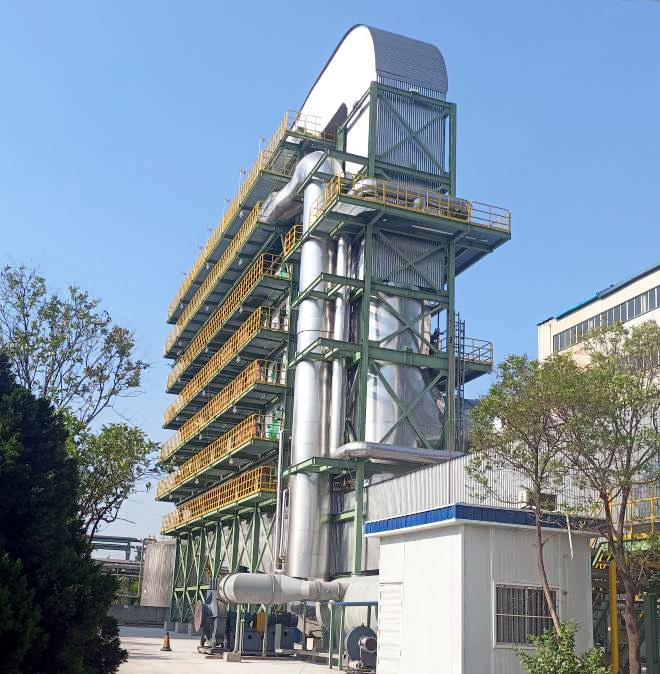The successful application of Fangxin Lihua ultra-low temperature denitrification catalyst in the Asia Pacific Senbo paper alkali recovery boiler ultra-low emission project
Publishdate:2021-09-15 Views:87
Recently, the 1500TDS/D paper alkali recovery boiler flue gas low-temperature denitrification project of Asia Pacific Senbo (Shandong) Pulp and Paper Co., Ltd. was successfully put into operation at the end of June 2021. The NOx emissions from the denitrification outlet met the standards and passed third-party testing.
The denitrification system of this project is constructed by Tongxing Environmental Protection Technology Co., Ltd., and the low-temperature denitrification catalyst is supplied by Beijing Fangxin Lihua Technology Co., Ltd.
The alkali recovery furnace for papermaking is mainly an equipment that generates steam by absorbing the heat of high-temperature flue gas discharged from combustion. It is an essential industrial equipment for pulp enterprises. The use of this boiler is not only a requirement for environmental protection, but also a requirement for circular economy in the pulp industry. Alkali recovery boiler is a type of boiler that uses the waste liquid (black liquid) discharged after alkaline papermaking pulp washing, which is concentrated and used as fuel to be sent into the furnace for combustion. After the black liquid is burned, it becomes liquid slag and is discharged from the bottom of the furnace. After being subjected to causticization, it is reduced to alkali; Steam becomes a secondary energy source for reuse.
This production process determines the smoke characteristics of the papermaking industry, such as the high moisture content in the smoke, which is about 25-35%; The dust is relatively fine, and in most cases, CEMS is difficult to monitor the accurate dust content; And the alkali metal content in the dust can reach over 90%. These factors will greatly affect the denitrification activity of catalysts, and even cause poisoning, thus becoming a challenge for flue gas denitrification in the industry. Fangxin Lihua underwent several months of industrial testing in the early stage, and made personalized formula adjustments to the catalyst to resist high moisture and alkali metals, optimize the production process, and ensure the smooth operation of the project. After the project is put into operation, the operating temperature is 170-190 ℃, and the NOx outlet concentration is 30-70 mg/Nm3, which is lower than the design value of 100 mg/Nm3.
The successful operation of this project marks the good adaptability of Fangxin Lihua low-temperature denitrification catalyst in the papermaking industry. In recent years, with the deepening of ultra-low emissions in the non electric industry, the R&D team of Fangxin Lihua has continuously experimented and solved problems. The catalyst's applicable temperature has been continuously reduced, and multiple application achievements have been created in various industries, including coking, sintering, steel rolling heating furnaces, garbage incineration, lime kilns, papermaking, glass, cement, silicon smelting, lithium industry, etc. This marks a new level of flue gas treatment in China.

Denitration reactor

Denitration reactor
Recently, the 1500TDS/D paper alkali recovery boiler flue gas low-temperature denitrification project of Asia Pacific Senbo (Shandong) Pulp and Paper Co., Ltd. was successfully put into operation at the end of June 2021. The NOx emissions from the denitrification outlet met the standards and passed third-party testing.
The denitrification system of this project is constructed by Tongxing Environmental Protection Technology Co., Ltd., and the low-temperature denitrification catalyst is supplied by Beijing Fangxin Lihua Technology Co., Ltd.
The alkali recovery furnace for papermaking is mainly an equipment that generates steam by absorbing the heat of high-temperature flue gas discharged from combustion. It is an essential industrial equipment for pulp enterprises. The use of this boiler is not only a requirement for environmental protection, but also a requirement for circular economy in the pulp industry. Alkali recovery boiler is a type of boiler that uses the waste liquid (black liquid) discharged after alkaline papermaking pulp washing, which is concentrated and used as fuel to be sent into the furnace for combustion. After the black liquid is burned, it becomes liquid slag and is discharged from the bottom of the furnace. After being subjected to causticization, it is reduced to alkali; Steam becomes a secondary energy source for reuse.
This production process determines the smoke characteristics of the papermaking industry, such as the high moisture content in the smoke, which is about 25-35%; The dust is relatively fine, and in most cases, CEMS is difficult to monitor the accurate dust content; And the alkali metal content in the dust can reach over 90%. These factors will greatly affect the denitrification activity of catalysts, and even cause poisoning, thus becoming a challenge for flue gas denitrification in the industry. Fangxin Lihua underwent several months of industrial testing in the early stage, and made personalized formula adjustments to the catalyst to resist high moisture and alkali metals, optimize the production process, and ensure the smooth operation of the project. After the project is put into operation, the operating temperature is 170-190 ℃, and the NOx outlet concentration is 30-70 mg/Nm3, which is lower than the design value of 100 mg/Nm3.
The successful operation of this project marks the good adaptability of Fangxin Lihua low-temperature denitrification catalyst in the papermaking industry. In recent years, with the deepening of ultra-low emissions in the non electric industry, the R&D team of Fangxin Lihua has continuously experimented and solved problems. The catalyst's applicable temperature has been continuously reduced, and multiple application achievements have been created in various industries, including coking, sintering, steel rolling heating furnaces, garbage incineration, lime kilns, papermaking, glass, cement, silicon smelting, lithium industry, etc. This marks a new level of flue gas treatment in China.

Denitration reactor

Denitration reactor




